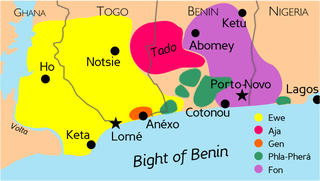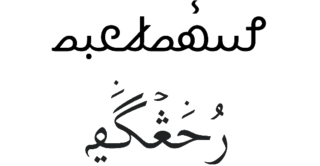
The culture of Angola is influenced by the Portuguese. Portugal occupied the coastal enclave Luanda, and later also Benguela, since the 16th/17th centuries, and expanded into the territory of what is now Angola in the 19th/20th centuries, ruling it until 1975. Both countries share prevailing cultural aspects: the Portuguese language and Roman Catholicism. However, present-day Angolan culture is mostly native Bantu, which was mixed with Portuguese culture. The diverse ethnic communities with their own cultural traits, traditions and native languages or dialects include the Ovimbundu, Ambundu, Bakongo, Chokwe, Avambo and other peoples.
A pitch-accent language is a type of language that, when spoken, has certain syllables in words or morphemes that are prominent, as indicated by a distinct contrasting pitch rather than by loudness or length, as in some other languages like English. Pitch-accent languages also contrast with fully tonal languages like Vietnamese, Thai and Standard Chinese, in which practically every syllable can have an independent tone. Some scholars have claimed that the term "pitch accent" is not coherently defined and that pitch-accent languages are just a sub-category of tonal languages in general.

Hadza is a language isolate spoken along the shores of Lake Eyasi in Tanzania by around 1,000 Hadza people, who include in their number the last full-time hunter-gatherers in Africa. It is one of only three languages in East Africa with click consonants. Despite the small number of speakers, language use is vigorous, with most children learning it, but UNESCO categorizes the language as vulnerable.

Fon also known as Dahomean is the language of the Fon people. It belongs to the Gbe group within the larger Atlantic–Congo family. It is primarily spoken in Benin, as well as in Nigeria and Togo by approximately 2.28 million speakers. Like the other Gbe languages, Fon is an isolating language with a SVO basic word order.
The Tagoi language is a Kordofanian language, closely related to Tegali, spoken near the town of Rashad in southern Kordofan in Sudan, about 12 N, 31 E. Unlike Tegali, it has a complex noun class system, which appears to have been borrowed from more typical Niger–Congo languages. It has several dialects, including Umali (Tumale), Goy, Moreb, and Orig. Villages are Moreb, Tagoi, Tukum, Tuling, Tumale, Turjok, and Turum.
Tumbuka is a Bantu language which is spoken in Malawi, Zambia, and Tanzania. It is also known as Chitumbuka or Citumbuka — the chi- prefix in front of Tumbuka means "in the manner of", and is understood in this case to mean "the language of the Tumbuka people". Tumbuka belongs to the same language group as Chewa and Sena.

Koasati is a Native American language of Muskogean origin. The language is spoken by the Coushatta people, most of whom live in Allen Parish north of the town of Elton, Louisiana, though a smaller number share a reservation near Livingston, Texas, with the Alabama people. In 1991, linguist Geoffrey Kimball estimated the number of speakers of the language at around 400 people, of whom approximately 350 live in Louisiana. The exact number of current speakers is unclear, but Coushatta Tribe officials claim that most tribe members over 20 speak Koasati. In 2007, the Coushatta Tribe of Louisiana, in collaboration with McNeese State University and the College of William and Mary, began the Koasati (Coushatta) Language Project as a part of broader language revitalization efforts with National Science Foundation grant money under the Documenting Endangered Languages program.

Rohingya is an language spoken by the Rohingya people of Rakhine State, Myanmar. It is a language belonging to the Bengali–Assamese branch, and is closely related to the Chittagonian language spoken in neighbouring Bangladesh. The Rohingya and Chittagonian languages have a high degree of mutual intelligibility.
Tonga (Chitonga), also known as Zambezi, is a Bantu language primarily spoken by the Tonga people who live mainly in the Southern province, Lusaka province, Central Province and Western province of Zambia, and in northern Zimbabwe, with a few in northwest Mozambique. The language is also spoken by the Iwe, Toka and Leya people among others, as well as many bilingual Zambians and Zimbabweans. In Zambia Tonga is taught in schools as first language in the whole of Southern Province, Lusaka and Central Provinces.
Tooro or Rutooro is a Bantu language spoken mainly by the Tooro people (Abatooro) from the Tooro Kingdom in western Uganda. There are three main areas where Tooro as a language is mainly used: Kabarole District, Kyenjojo District and Kyegegwa District. Tooro is unusual among Bantu languages as it lacks lexical tone. It is most closely related to Runyoro.
Wolaitta or Wolayttatto Doonaa is a North Omotic language of the Ometo group spoken in the Wolayita Zone and some other parts of southwestern Ethiopia. It is the native language of the Welayta people. The estimates of the population vary greatly because it is not agreed where the boundaries of the language are.
Proto-Indo-European accent refers to the accentual (stress) system of the Proto-Indo-European language.
Nyamwezi is a major Bantu language of central Tanzania. It forms a dialect continuum with Sukuma, but is more distinct from it.
Lithuanian has eleven vowels and 45 consonants, including 22 pairs of consonants distinguished by the presence or absence of palatalization. Most vowels come in pairs which are differentiated through length and degree of centralization.
In the Lithuanian phonology, stressed heavy syllables are pronounced in one of two prosodically distinct ways. One way is known as the acute or falling accent: this may be described as "sudden, sharp or rough". In Lithuanian it is called tvirtaprãdė príegaidė, literally 'firm-start accent'. The second way is known as the circumflex or rising accent, which may be described as "continued, mild or smooth". In Lithuanian it is called tvirtagãlė príegaidė, literally 'firm-end accent'. Light syllables may be stressed or unstressed, but cannot be differentiated by accent.
Serbo-Croatian is a South Slavic language with four national standards. The Eastern Herzegovinian Neo-Shtokavian dialect forms the basis for Bosnian, Croatian, Montenegrin, and Serbian.
Vanimo is a Skou language of Papua New Guinea which extends from Leitre to Wutung on the Papua New Guinea - Indonesian border.
Proto-Slavic is the unattested, reconstructed proto-language of all Slavic languages. It represents Slavic speech approximately from the 2nd millennium BC through the 6th century AD. As with most other proto-languages, no attested writings have been found; scholars have reconstructed the language by applying the comparative method to all the attested Slavic languages and by taking into account other Indo-European languages.
Proto-Bantu is the reconstructed common ancestor of the Bantu languages, a subgroup of the Southern Bantoid languages. It is thought to have originally been spoken in West/Central Africa in the area of what is now Cameroon. About 6,000 years ago, it split off from Proto-Southern Bantoid when the Bantu expansion began to the south and east. Two theories have been put forward about the way the languages expanded: one is that the Bantu-speaking people moved first to the Congo region and then a branch split off and moved to East Africa; the other is that the two groups split from the beginning, one moving to the Congo region, and the other to East Africa.
Thilo Christian Schadeberg is an Emeritus Professor of Bantu Linguistics at the Centre for Linguistics of Leiden University.




